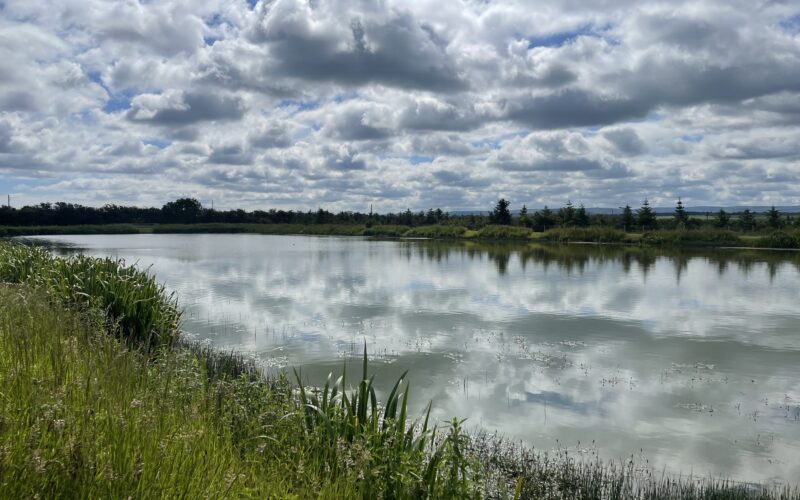There is one clear message from the various studies predicting future rainfall patterns in Scotland: the likelihood and severity of drier summers could double by the middle of this century. This is particularly expected to affect the eastern half of the country.
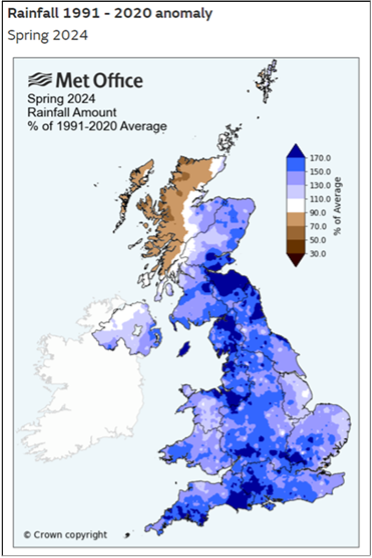
A recent report by the Centre of Expertise for Waters (CREW) entitled) “Future Predictions of Water Scarcity in Scotland: Impacts to Distilleries and Agricultural Abstractors | CREW | Scotland’s Centre of Expertise for Waters” (17 June 2024) goes into greater depth and is essential reading for those in water-vulnerable businesses. This article looks in more detail at potential impacts from reduced water availability on crop and livestock producers.
Insufficient water just when it’s needed most can have catastrophic impacts on crop viability and yield, so planning is key to security. If you are considering a borehole supply or lagoon storage, a recent article, Securing your Water Supply with Boreholes and Lagoons | Helping farmers in Scotland | Farm Advisory Service (fas.scot), by the Farm Advisory Service, discusses these options.
Whether either of these alternative water supply options is suitable for your business or financially viable depends on individual circumstances, but there may also be the potential to share the costs and benefits with neighbouring farms.
So, what is the scarcity situation so far in 2024? Above average rainfall in many places over last Autumn and this Spring, coupled with generally lower temperatures, means that soil moisture deficits, groundwaters, rivers, lochs and reservoirs, are more replete with water than in July of 2023. The Met Office is predicting a 60% chance of average rainfall over the next few months, with a 20% chance it may be wetter or drier than the long-term average. Scotland is experiencing very intense, localised, rainfall this Summer and this is likely to become the norm. Also, during the next few months temperatures are predicted to be warmer on average (50% chance), or at least average (45% chance), which may also increase water requirements.
Wetter conditions at the start of this season means that SEPA has not yet had to issue any water scarcity alerts, unlike 2023 when several areas were at Significant scarcity throughout June, and many more at Moderate.
The following graph shows the number of areas reported by SEPA at alert or above for 2020-2023 and illustrates how water scarcity can occur at any time from late Spring into early Autumn. In 2023 water scarcity occurred especially early in the season and was widespread, with all reported areas at Alert or above.
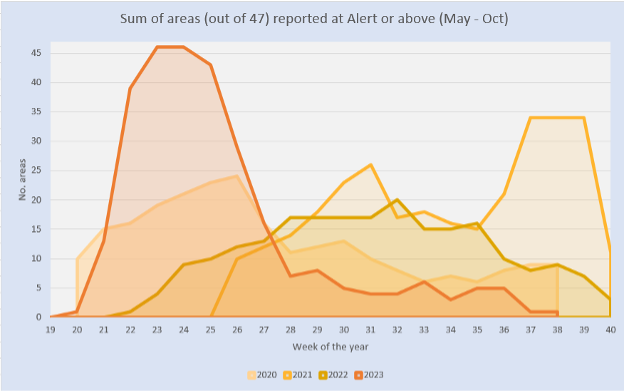
Many will remember the very dry 2018 season, when scarcity warnings were extensive across most of the country from July into September. In a typical year scarcity can also vary considerably geographically across Scotland. During the summer there will be various areas under some level warning, whilst other areas are completely unaffected, and this pattern can change from year to year. Low river flows are of course to be expected – a low flow (i.e. a flow exceeded for 95% of the time) will occur on average for about 18 days in every year, although not necessarily consecutively. If this period of low river flows extends beyond 30 days we are then at Significant scarcity i.e. drought conditions.
New from SEPA in 2024 is a messaging service to more rapidly advise abstraction licence holders of changes to the water scarcity situation. In the past few years we have routinely contacted abstractors by email in the early stages of water scarcity to provide information and advice. If you hold a permit you may have had an email message from SEPA on 5 July letting you know that we can now advise you of any changes to the water scarcity status via a text message. If you did not get that email and you hold an abstraction licence, please contact us at WaterScarcity@sepa.org.uk and we can send you future email updates. If you also provide a mobile phone number, SEPA can send you a short text message (this will be a brief message and sent only during normal working hours). Prompt messaging can be vital, particularly when your area is at Moderate or Significant scarcity, and especially in circumstances where SEPA has had to temporarily suspend a licence, or vary it to reduce the allowable volume. A text message would also let you know immediately when these restrictions are lifted. SEPA will continue to contact businesses likely to be subject to some abstraction restrictions (at Significant water scarcity) directly by telephone where we have contact details available.
Understanding the impact of removing water from the environment depends on having accurate information. SEPA’s gauging station network allows us to understand what’s happening within many of our main rivers, but the other essential factor is a detailed knowledge of where and when water is being abstracted. That is why an obligation to make data returns is a condition of every abstraction licence we issue. Installing a meter on each pump is the best option to measure the volume abstracted and can also allow businesses to ensure water is being used in the most efficient and sustainable way. Accurate data returns are necessary to ensure a fairer and more equitable water allowance for abstractors throughout a river catchment whilst ensuring protection of the aquatic environment.
There is no easy answer to water scarcity. If there’s insufficient rainfall there is potentially no water available, and this may become more common and more severe. Given future climate projections it makes sense from a business security perspective to plan now and consider your options.
If you have any questions please contact SEPA at: WaterScarcity@sepa.org.uk
Additional rainfall maps
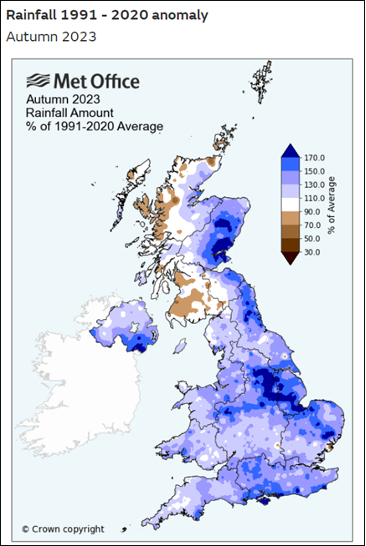
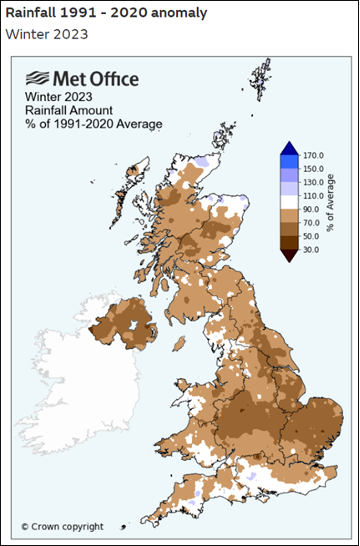
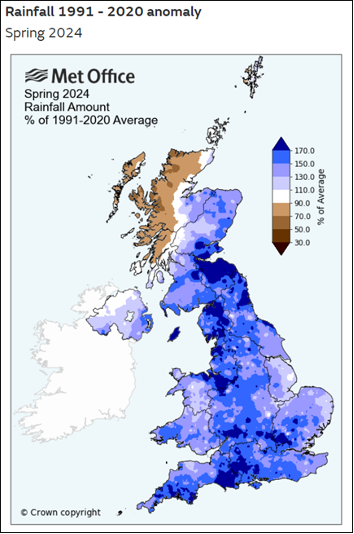
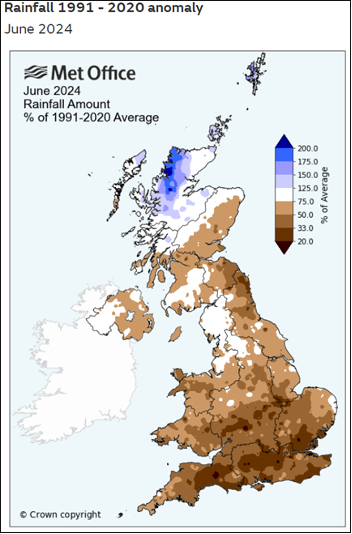
Related resources
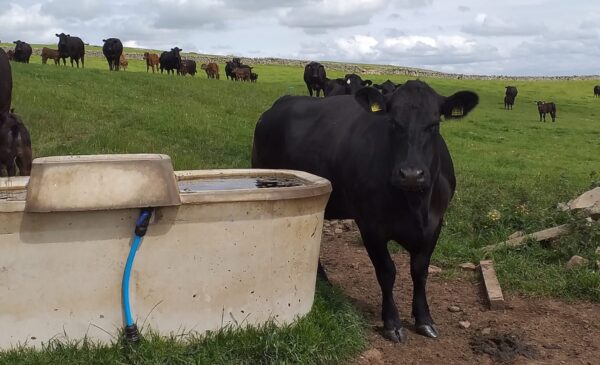
Newsletter Summer 24 Newsletter
You don’t always need a pump!
Robert Ramsay, SAC Consulting
Discussing alternative watering with farmers is always an enjoyable challenge. From crofters in the Western…
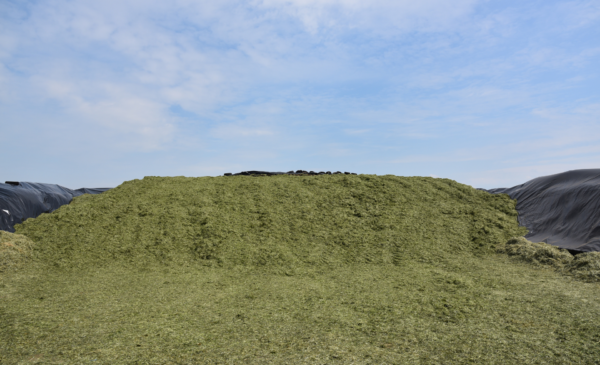
Newsletter Summer 24 Newsletter
Are you planning on upgrading or constructing a silage pit? If so, plan ahead
Jackie McColm, SEPA
Any structures currently in use that were built, substantially reconstructed, or enlarged after 1st September…
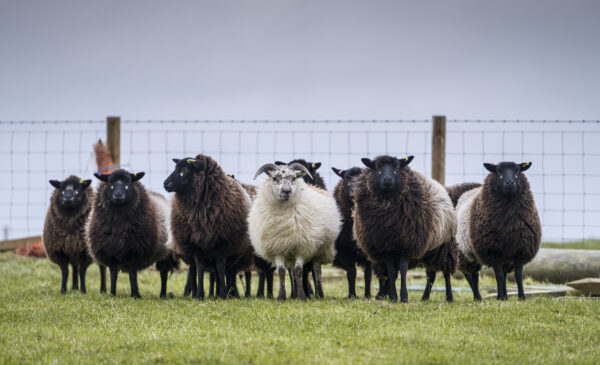
Newsletter Summer 24 Newsletter
Sheep Scab: Right way to dip sheep
Laura Henderson, SAC Consulting
What is sheep scab? Sheep scab is an allergic dermatitis in response to infestation with…

